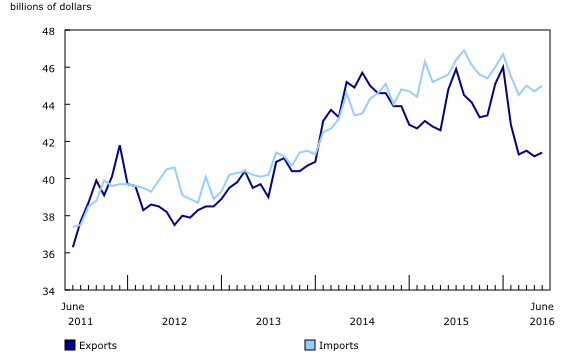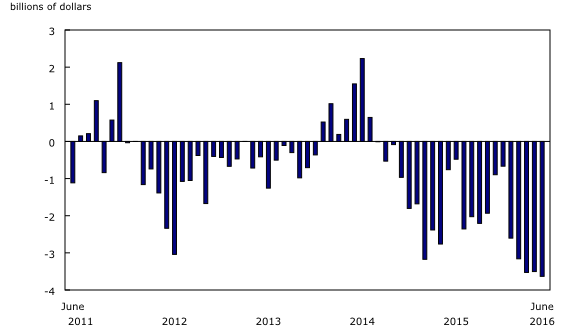Canadian international merchandise trade, June 2016
Archived Content
Information identified as archived is provided for reference, research or recordkeeping purposes. It is not subject to the Government of Canada Web Standards and has not been altered or updated since it was archived. Please "contact us" to request a format other than those available.
Released: 2016-08-05
Canada's imports increased 0.8% to $45.0 billion in June. Import volumes were up 0.7% and prices rose 0.2%. Exports increased 0.6% to $41.4 billion, as prices were up 2.0%, while volumes fell 1.4%. As a result, Canada's merchandise trade deficit with the world widened from $3.5 billion in May to a record $3.6 billion in June.
In the second quarter, imports decreased 1.4% to $134.7 billion. Exports dropped 4.7% to $124.0 billion, the largest decline since the second quarter of 2009. Consequently, Canada's quarterly trade deficit with the world widened from $6.4 billion in the first quarter of 2016 to a record $10.7 billion in the second quarter.
Trade surplus with the United States narrows in June
Imports from the United States were up 1.5% to $29.8 billion and exports were down 1.2% to $31.6 billion. As a result, Canada's trade surplus with the United States narrowed from $2.6 billion in May to $1.8 billion in June.
Exports to countries other than the United States increased 6.9% to $9.8 billion in June. There were higher exports to the United Kingdom (+$274 million), Spain (+$90 million), South Korea (+$86 million) and China (+$85 million). Imports from countries other than the United States decreased 0.5% to $15.2 billion. Lower imports from Switzerland (-$189 million) and Norway (-$112 million) were largely offset by higher imports from Germany (+$168 million) and Saudi Arabia (+$123 million). Consequently, Canada's trade deficit with countries other than the United States narrowed from a record $6.1 billion in May to $5.4 billion in June.
Higher imports driven by motor vehicles and parts, and energy products
Total imports rose 0.8% to $45.0 billion in June, despite losses in 6 of 11 sections. Higher imports of motor vehicles and parts, energy products, and electronic and electrical equipment and parts were partially offset by lower imports of aircraft and other transportation equipment and parts. Year over year, total imports were down 1.2%.
Imports of motor vehicles and parts reached a record high in June, up 3.6% to $9.1 billion. The gain was led by passenger cars and light trucks (+6.3%), which increased for the seventh consecutive month to reach a record high of $4.2 billion. Overall, volumes rose 3.9%, while prices edged down 0.3%.
In June, imports of energy products increased 12.7% to $2.4 billion. The gain was attributable to higher imports of refined petroleum energy products, up 30.8% to $894 million, mainly on higher volumes. For the section as a whole, volumes were up 10.3%, and prices advanced 2.2%.
Also contributing to the overall gain in June, imports of electronic and electrical equipment and parts were up 3.1% to $5.3 billion. Specifically, there were higher imports of communications and audio and video equipment, up 4.9% to $1.7 billion, and electronic and electrical parts, up 8.2% to $781 million. Overall, volumes rose 2.6% and prices increased 0.5%.
Partially offsetting these gains, imports of aircraft and other transportation equipment and parts fell 22.0% to $1.4 billion in June. This is the second consecutive monthly decline, following a record high in April. Lower imports of aircraft engines and aircraft parts (-21.3%) and aircraft (-26.4%) were mainly responsible for the decrease.
Exports increase on higher energy product prices
Total exports were up 0.6% to $41.4 billion, with 6 of 11 sections increasing in June. Higher exports of energy products and basic and industrial chemical, plastic and rubber products were partially offset by lower exports of metal and non-metallic mineral products. Exports excluding energy products were down 0.4%. Year over year, total exports decreased 7.6%.
Exports of energy products rose 7.2% to $5.7 billion in June, the fourth consecutive monthly gain. Crude oil and crude bitumen advanced 6.8% to $4.1 billion, as prices were up 9.1%. Also contributing to the increase were higher exports of natural gas, up 20.0% to $664 million, as prices rose 32.3%. For the section as a whole, prices increased 11.7%, while volumes fell 4.0%.
In June, exports of basic and industrial chemical, plastic and rubber products rose 5.2% to $2.8 billion. There were higher exports of plastic resins (+9.3%), dyes and pigments, and petrochemicals (+26.4%), and basic chemicals (+5.5%). Overall, volumes increased 2.9%, and prices were up 2.2%.
Moderating these gains, exports of metal and non-metallic mineral products fell 6.9% to $4.2 billion in June. Unwrought precious metals and precious metal alloys decreased 13.0% to $1.3 billion, on lower exports of unwrought gold to the United States and Hong Kong. Also contributing to the decline were lower exports of unwrought nickel and nickel alloys, down 17.5% to $256 million, the lowest level since January 2010. For the section as a whole, volumes fell 6.4%, and prices were down 0.5%.
Monthly and quarterly real trade deficits
In real (or volume) terms, imports increased 0.7% in June, as higher imports of motor vehicles and parts and energy products were partially offset by lower imports of aircraft and other transportation equipment and parts. Export volumes were down 1.4%, as there were lower exports of energy products and metal and non-metallic mineral products. Consequently, Canada's trade deficit in real terms widened from $170 million in May to $984 million in June.
In the second quarter, import volumes edged up 0.2%. Higher imports of energy products and aircraft and other transportation equipment and parts were mostly offset by lower imports of consumer goods and industrial machinery, equipment and parts. Quarterly export volumes fell 5.0% on lower exports of motor vehicles and parts and consumer goods. As a result, Canada's quarterly trade balance in real terms went from a $5.5 billion surplus in the first quarter to a $923 million deficit in the second quarter.
Revisions to May imports and exports
Revisions reflected initial estimates being updated with or replaced by administrative and survey data as they became available and amendments made for late documentation of high-value transactions. Imports in May, originally reported as $44.4 billion in last month's release, were revised to $44.7 billion with the current month's release. Exports, originally reported as $41.1 billion in last month's release, were revised to $41.2 billion.
Note to readers
Merchandise trade is one component of Canada's international balance of payments (BOP), which also includes trade in services, investment income, current transfers, and capital and financial flows.
International trade data by commodity are available on both a BOP and a customs basis. International trade data by country are available on a customs basis for all countries and on a BOP basis for Canada's 27 principal trading partners (PTPs). The list of PTPs is based on their annual share of total merchandise trade—imports and exports—with Canada in 2012. BOP data are derived from customs data by making adjustments for factors such as valuation, coverage, timing and residency. These adjustments are made to conform to the concepts and definitions of the Canadian System of National Accounts.
For a conceptual analysis of BOP versus customs based data, see "Balance of Payments trade in goods at Statistics Canada: Expanding geographic detail to 27 principal trading partners."
For more information on these and other macroeconomic concepts, see the Methodological Guide: Canadian System of Macroeconomic Accounts (13-607-X) and User Guide: Canadian System of Macroeconomic Accounts (13-606-G), available from the Browse by key resource module of our website, under Publications.
Data in this release are on a BOP basis, seasonally adjusted and in current dollars. Constant dollars are calculated using the Laspeyres volume formula (2007=100).
For information on seasonal adjustment, see Seasonally adjusted data – Frequently asked questions.
Revisions
In general, merchandise trade data are revised on an ongoing basis for each month of the current year. Current year revisions are reflected in both the customs and BOP based data.
The previous year's customs data are revised with the release of the January and February reference months and on a quarterly basis. The previous two years of customs based data are revised annually and revisions are released in February with the December reference month.
The previous year's BOP based data are revised with the release of the January, February, March and April reference months. To remain consistent with the Canadian System of Macroeconomic Accounts, revisions to BOP based data for previous years are released annually in December with the October reference month.
Factors influencing revisions include late receipt of import and export documentation, incorrect information on customs forms, replacement of estimates produced for the energy section with actual figures, changes in classification of merchandise based on more current information, and changes to seasonal adjustment factors.
For information on data revisions for crude oil and natural gas, see "Revisions to trade data for crude oil and natural gas."
Revised data are available in the appropriate CANSIM tables.
Real-time CANSIM tables
Real-time CANSIM table 228-8059 will be updated on August 15. For more information, consult the document, Real-time CANSIM tables.
Next release
Data on Canadian international merchandise trade for July will be released on September 2.
Products
Customs based data are now available in the Canadian International Merchandise Trade Database (65F0013X). From the Browse by key resource module of our website, choose Publications.
The June 2016 issue of Canadian International Merchandise Trade, Vol. 70, no. 6 (65-001-X), is also available from the Browse by key resource module of our website, under Publications.
Contact information
For more information, contact us (toll-free 1-800-263-1136; 514-283-8300; STATCAN.infostats-infostats.STATCAN@canada.ca).
To enquire about the concepts, methods or data quality of this release, contact Benoît Carrière (613-415-5305; benoit.carriere@canada.ca), International Accounts and Trade Division.
- Date modified:




